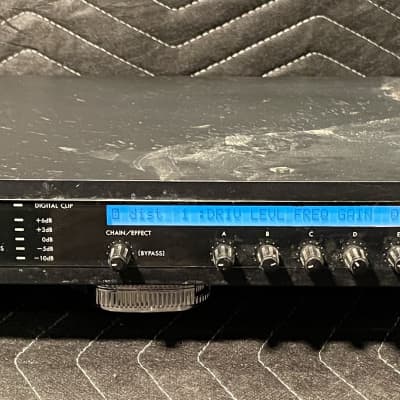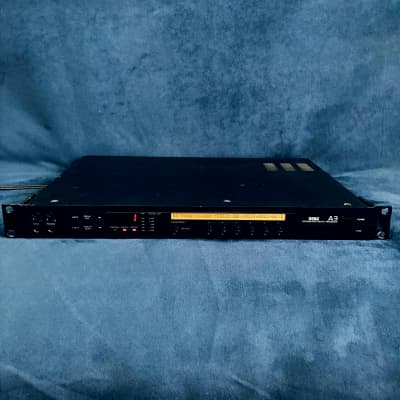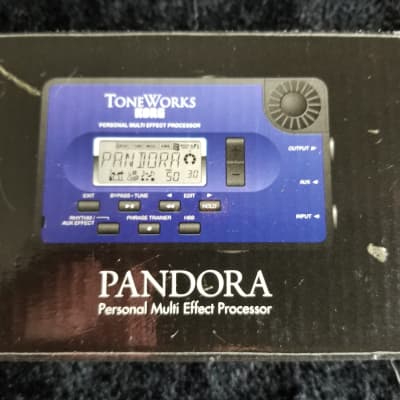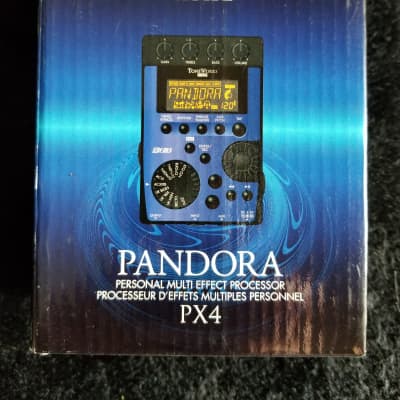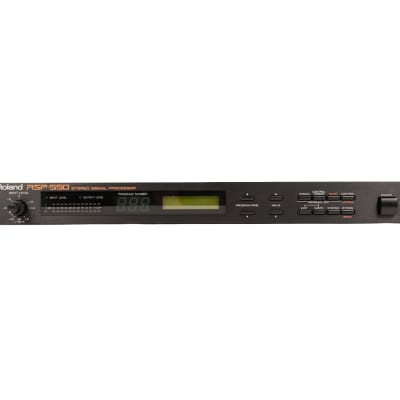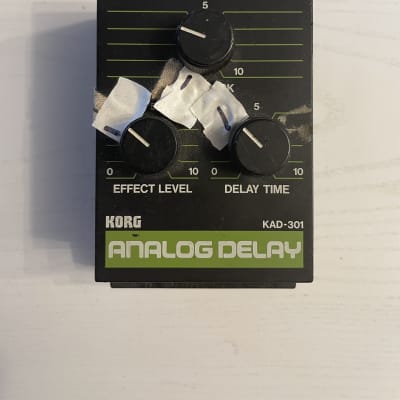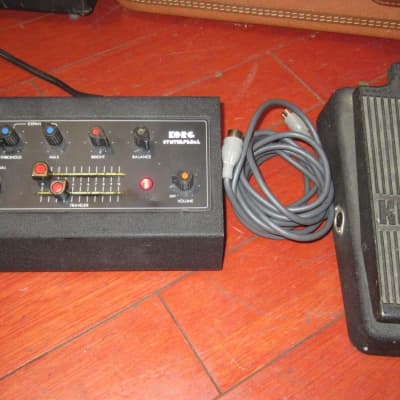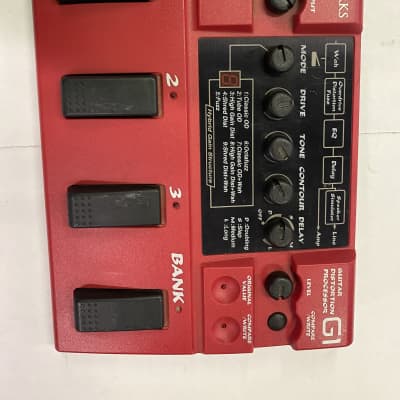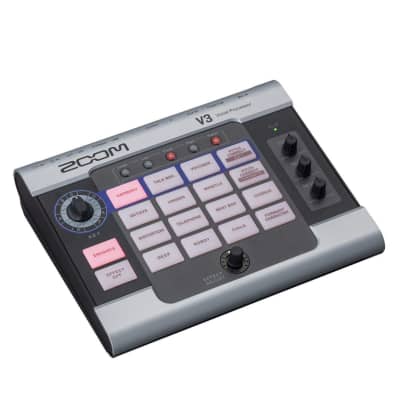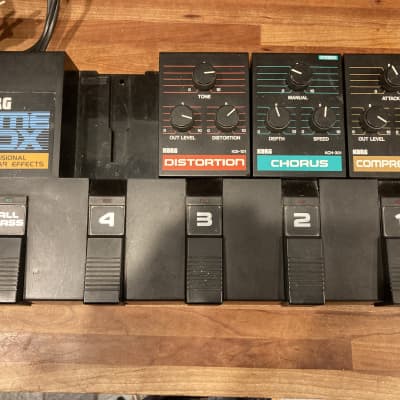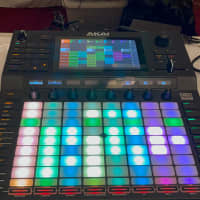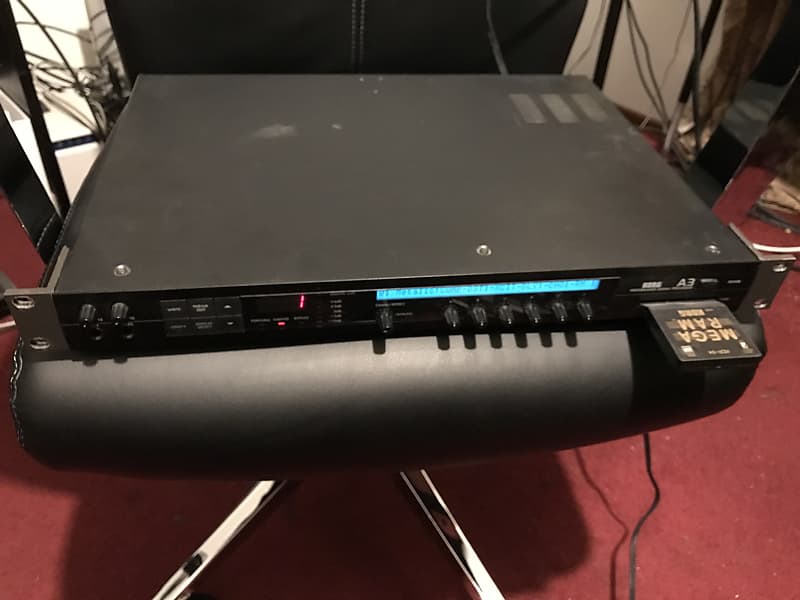

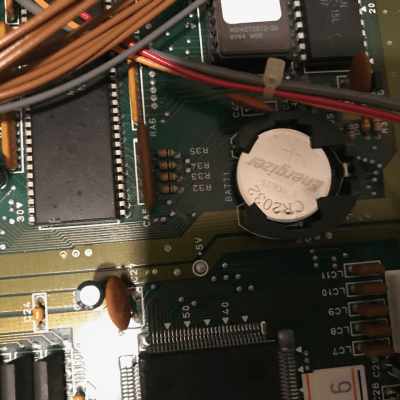
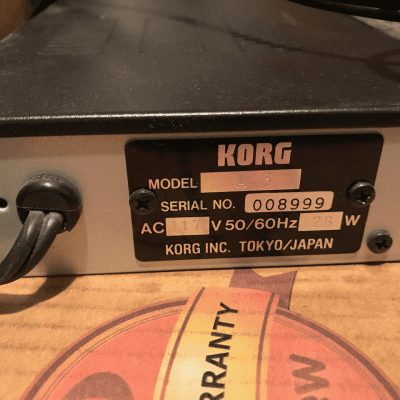
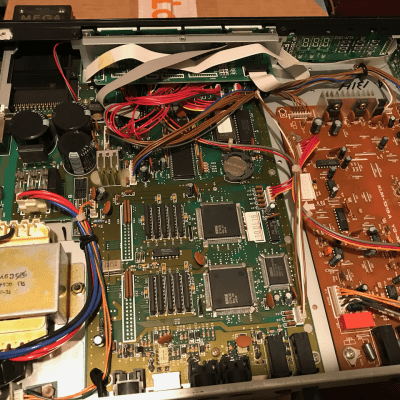
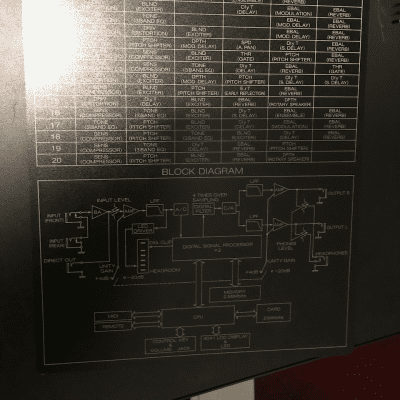
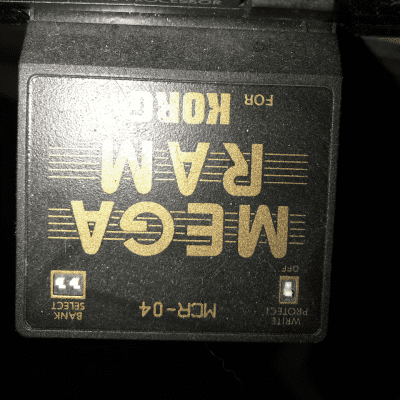
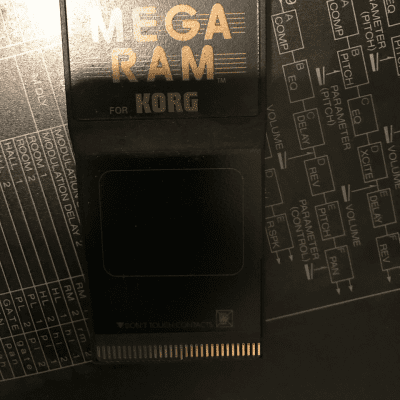
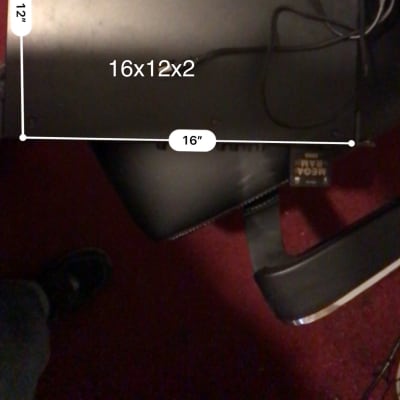

IT SEEMS INCREDIBLE to think that Yamaha's
SPX90 only appeared on the market some four years ago - and in doing so,
opened the door for the multi-effects unit. Most manufacturers have
followed suit in the ensuing time, to the point where 16-bit, 18kHz
bandwidth units are commonplace, as is the ability to chain together
four or more effects at the same time.
Unfortunately, as with MIDI synths, we've seen the demise of the knob,
and the simple, immediate form of control it affords. Also, the
configuration of multi-effects units - the order in which the effects
are chained together - is often limited to a handful of options, with
the notable exception of the Yamaha SPX900/1000 series.
Korg appear to have sat back and looked at the field, with the intention
of ensuring that the criticisms which have been leveled at the
competition will not be directed at their A3.
ENCASED IN A black 1U-high, 19' rack-mount case, the A3 has one of the
better front panel layouts, with the visual side taken care of by a
40-character back-lit LCD screen, input bar meter, patch number and
status LEDs. What makes this unit special is the seven twin function
controls sitting beneath the display. These appear to be rotary knobs
but also act as push buttons, whose functions depend on the mode in
which the A3 is being operated.
Audio input and headphone levels are dealt with by conventional knobs,
and each has a dedicated front-panel jack socket with the one for input
overriding that on the rear panel. A bank of six keys for editing and
general manipulation complete the front end. The rear has mono jack
sockets for audio input, direct audio out, right and left stereo outs
and two footswitches along with MIDI In, Out and Thru, and a remote
control socket. Input level can be matched with connected equipment via a
+4/-20dB switch.
THERE ARE 41 effects onboard the A3 as standard. Of these, six can be
used at any one time, subject to the 20 preset chains, or effect
connection patterns, which exist for each of 100 memory patches. This is
like having 100 sets of 20 footpedals, each with different settings.
The effects fall into certain groupings, each of which have suitable
parameters. The most significant of these have been picked out below.
The A3's control parameters break down as follows: Reverb group offers
two each of Room, Hall and Plate reverb groups having decay times of up
to five seconds, pre-delay, high frequency damping, EQ (two-band);
Distortion (four types, with drive and a single-band parametric EQ with
contour "Q" shape); Delay has three separate groups - Mono, Stereo
(including cross-pan) and Modulation, each of which have delay time and
feedback, with the latter having LEO controls; Modulation has two each
of Chorus and Flange, the difference being the type of LFO generator
(sine wave/triangle) with similar controls to the previous group; Early
Reflection is essentially gated reverb, again with two-band EQ; Speaker
Simulation attempts to copy the driving of a loudspeaker and has three
different types with emphasis presets for mid and high; Pan moves the
signal between the stereo outputs and Phaser uses phase inversion of the
signal with two types of each, again dependent on the choice of LFO.
The final effects only have a single type with settings normally
attributable to the particular effect - Compressor, Parametric EQ
(two-band with Q), Pitch Shift (PL/MI 1 semitone), Exciter, Ensemble
(strong choral effect), Rotary Speaker, 3-band EQ (no Q), Pedal Pan and
Wah via the volume pedal and Gate).
THE UNIT POWERS up in Individual Play mode, the display showing the
chain number along with the name of the patch and the possible effects
for the chain. For instance, chain 5 has Compressor, Distortion,
Exciter, Delay, Phaser and Reverb in that order, with each effect having
one of the six rotaries (labelled A to F) situated beneath it. Pressing
any of these buttons turns the effect off and changes the letters from
upper to lower case. Twisting these knobs allows selection from the
effects within the particular group - In this case, turning the Reverb
select knob will select from the six different types of reverb setting.
The seventh knob is used to bypass all effects (by pressing it), at
which point the LED lights up, or to select which of the 20 chains is
being used (by rotating it). To change the patch, there are a pair of
key cursors which will increment or decrement the patch number and show
the chain which was on display when that patch was saved.
Pressing the Display Select key changes modes, from Individual to
Performance. Each effect group has one parameter which has been judged
to be the most important, and the display changes from the name of the
effect to the name of this parameter as Display Select is toggled.
Continuing with our example, Distortion can have the drive altered while
Reverb can have the effect balance altered. The only problem here is
that there is no visual indication of what the value of the parameter
was or has been changed to. Nevertheless, the chosen parameters
certainly make editing quick.
"ROM cards can be used to load in new effects in chains and programs - properly supported, it could be a long time before the A3 is out of date."
A push on the Parameter Edit key prompts the name of the patch to change
to Select. Dial up the required chain by using the extra rotary and
press any of the effects. This brings up the next page on the display,
with the allocated editing parameters and a letter on the left-hand side
of the screen showing which effect has been selected. If the Reverb is
chosen, an F and the parameter's reverb time, high frequency damping,
pre-delay, low and high EQ and effect balance appear in the display.
Rotating any of the knobs will immediately change the associated
parameter, but instead of changing from the previous value, movement of
the knob causes the parameter to jump to the current value indicated by
the knob. About two seconds after the edit, the display will revert to
the name of the parameter. Again this is quick to use but will probably
entail the use of pencil and paper to write down the initial settings
before editing starts. Of course, there is another way: press Display
Select and all current values will be shown in place of the parameter
name, making it possible to continuously toggle between the two
displays. This tends to be rather tedious until you commit the names and
positions of the parameters to memory.
One gripe that I have is that the actual parameter value is of little
real significance in many cases. For instance, the attack on the
Compressor can take a value between 0 and 20 - however, this does not
appear to be time-based. Similarly, the high-frequency damping factor
which appears on many of the effects can vary between 0 and 99, but
again isn't time- or ratio-based. This means that instant setting up of a
parameter by its numerical value is difficult.
Utility mode is used for both patch and global parameters. Name and
overall gain for a patch can be set, as well as the threshold control
for the inbuilt noise reduction system, which is a preset noise gate.
The two rear controller sockets can be told their true purpose in life
with the choice of program up/down, bypass or the speed of the rotary
speaker in the case of a footswitch, and volume and parameter setting if
a continuous pedal is used. The other two functions, MIDI and Card,
will be covered later.
Finally, Write mode allows you to save your edited patch. For some
reason, there is no write protect facility on the A3, which I would have
expected bearing in mind the degree of programming possible - you have
been warned.
THE BOTTOM LINE for any effect unit is its sound quality, and the A3 is
impressive in this respect. In fact, having compared it with a Yamaha
SPX1000 I found it very difficult to tell the difference. Perhaps, as
Yamaha own Korg, this isn't surprising, but the microprocessors doing
the work are apparently slightly different. Any concern over only having
a mono input is dispelled immediately upon hearing, or "seeing", the
stereo image. Personally, I have never been impressed with units which
boast stereo inputs unless the two channels can be used independently.
The A3 has the advantage that as a stereo effect always comes before the
reverb, more "spread" to the sound is created, and this spacious
quality shows itself in many of the patches.
Looking at individual effects and their uses, the reverbs are
practically grain-free and have a more than adequate set of parameters.
The stereo delay group deserves a special mention, especially the cross
delay which has its input fed from the other channel's delay output.
This occurs in chain 6 with ensemble and reverb following it, and the
flashing delays create a really dynamic effect. Similarly in chain 10,
the stereo delay is fed via a pitch changer, modulation and pan to
create a fat ping-pong effect which can then be cross delayed and
finished by passing through a reverb.
With distortion, speaker simulation and pedal wah, it would be
reasonable to expect to be able to get a good guitar sound. Chain 8 has
all three of these as well as EQ, modulated delay and reverb, and really
kicks out an American lead guitar sound. Distortion appears to have the
drive set at halfway on all patches (I prefer to see it set to 11). The
performance parameter for distortion just happens to be... drive.
Nicely thought out in that respect.
Quite a few of the chains have the distortion preceded by the
compressor, and this combination is guaranteed to give noise with a
capital N. The noise gate is necessary to disguise the noise generated,
but care has to be taken when assigning a value to this in the Utility
page, otherwise the output "chatters" if the noise level hovers around
the threshold which has been set. Use of the compressor makes this
setting rather difficult to get right.
"The mixture of rotary and push button control is sheer genius and makes me wonder why other manufacturers have made us put up with less."
The exciter really doesn't have the cut expected from such an effect,
and seems to be no more than an extra equaliser of sorts - anyone that
has spent time working with a real exciter will appreciate the
difference. The parametric equaliser has only a single Q control for the
two bands that it can work over, which certainly compromises its use.
The low band starts at 100Hz which means that any mains-borne hum cannot
be removed. The 3-band equaliser has the same low and mid band as the
parametric and a high band whose top response is identical to that of
the mid band - 8kHz, which is really too low. Neither of these really
offer sufficient control over the equalisation of an effect.
Finally, it is worth mentioning that accidental creation of distortion
is a little too easy for my liking. It comes about because many of the
effects have gain controls and the increase in overall gain doesn't show
up on the input meter - there really should be a separate meter for
output.
WITHOUT GOING INTO too much detail, the optional FC6 has two modes; the
first allows you to change programs, while the second allows you to turn
individual effects on and off as an alternative to using the push
buttons on the front panel. It has four jack sockets on the rear for
connecting two switches and two pedals; the former are for switching
between the modes of the FC6 and operating the bypass switch on the A3,
while the latter are used for volume and individual effect parameters,
which can be set from the Utility page on the A3. This certainly opens
up the scope of the A3 for live work, especially on the effects loop
from an amplifier or via the auxiliaries on a mixing desk.
WHEN THE LIKES of the Alesis Quadraverb has the ability to address eight
parameters per patch via MIDI, it seems fair to expect that some degree
of MIDI control would be forthcoming on the A3. Unfortunately it would
appear that this technology has yet to reach Korg as, according to the
MIDI information and Implementation chart, no parameters can be
addressed via MIDI. However, page 30 of the manual mentions that the
speed of the rotary speaker can be changed in real time by using an
external MIDI instrument and "Transmitting data through MIDI over the
same program number as being currently used by the A3". I'm not quite
sure what that's supposed to mean, because data transference takes place
over a MIDI channel, not a program number. Hopefully Korg will
enlighten us as to the true meaning of this in due course.
With respect to what can be done via MIDI, an internal bulk dump can be
initiated from the Utility page and the data transmitted to a sequencer.
It would appear that a single patch dump has not been implemented, even
by an external command. This is a shame as it would make the A3 easier
to use from a real-time mixing point of view, as would the ability to
change parameters over MIDI. Transferring from memory to card and vice
versa, and program changes are the only other MIDI functions catered
for.
AS YOU MIGHT expect, RAM cards are available for the saving of all the
internal data, namely patches 1-100. These are written to card as 101 to
200 and can then be loaded back into the A3. It would appear that only
an entire memory dump is possible, but as I didn't have access to a
card, I couldn't check. ROM cards can be used to load in new effects in
chains and programs which could be most interesting. Imagine, perhaps a
full blown harmoniser or a sampler... The possibilities are limitless
and, if this unit is properly supported, it could be a long time before
it is out of date, as it can ride on the wave with technology.
THE KORG A3 is a high-quality unit built with flexibility and ease of
use in mind. The mixture of rotary and push button control is sheer
genius and makes me wonder why other manufacturers have made us put up
with less. The inevitable noise build-up when using six effects is
satisfactorily masked by the internal noise gate, and the promise of new
effects and chains being available via ROM cards is most reassuring.
At £899, how much better is the A3 than the ubiquitous Quadraverb? More
effects perhaps, but not a substantially better sound quality. The
criteria for choice then comes down to whether the extra effects are
what you require.
Price £899 including VAT
- - - - - - - - - - - - - - - - - - - - - - - - - - - - - - - - - - - - - - - - - - - - - - - - - - - - - - - - - - - - - - - - - - - - -
Effects Processor - previously owned by the band Earth, Wind and Fire. This unit has rack ears and the coin battery has been replaced 2020 with an Energizer 2032 coin battery.
I originally bought one of these new in 1988 - wow, the price tag of 1199$ was steep then and this effects unit is really the best unit I've ever owned, and incorporated into albums.
* I think this is a no brainer of a buy. It works with Vocals, Guitar or Keys.
* I have the original plastic mapping card and will be included.
* * * International shipping rates and policies are per fedex and may be subject to change.
* * * Shipping box size due to change as dimensions of unit and accessories may require a larger box.
Reverb Buyer Protection
Reverb has your back if your item is lost, damaged, or doesn't match its description. Simply report any issues within 7 days and we'll help you get a full refund.Learn more about Reverb Buyer Protection.
| Listed | 3 years ago |
| Condition | Very Good (Used) Very Good items may show a few slight marks or scratches but are fully functional and in overall great shape.Learn more |
| Brand | |
| Model |
|
| Finish |
|
| Categories | |
| Year |
|
| Made In |
|
